BDP8: Building the University of Science
Posted by Huw,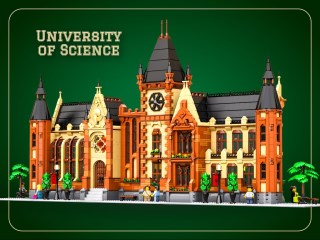
Voting for BrickLink Designer Program series eight ends on Friday so we just have time to squeeze in a couple more articles about some of the submissions.
In this one, KingCreations goes into detail about his University of Science project:
The start of the Bricklink Designer Program (BDP) a couple of years ago encouraged me to experiment more with creating MOCs to share with others. Since then, I’ve created over a dozen submissions for the program and am extremely fortunate to have had Camping Adventure in series 3 and Off-Road Adventure in series 6 selected as finalists.
Although I’ve created many different kinds of builds in many different themes, one area I was always interested in was creating some education for our minifigures. LEGO has created surprisingly few sets in this theme, especially sets fitting for an adult fan’s city layout. This theme started with my series 4 submission, Northpoint School, a model that has continued to evolve and is still being submitted under the name Northpoint Academy. Positive feedback from that model encouraged me to continue exploring educational-themed sets, and the concept of a university for minifigures to further their education seemed fitting.
I first started designing a university-themed model for series 5, but it didn’t work out. It began as a modular-type submission, but rule changes implemented around that time prevented future submissions in the Icons modular format. Additionally, the design was primarily done in tan and ended up looking a bit too plain compared to what I was imagining, and the part count was quickly inflating past what I was aiming for.
The Design
After that first attempt, I took a break from the idea of a university and focused on other designs. After series 6, however, I decided to give it another try with some lessons learnt from that first design. Instead of just tan in the design, I decided to have dark orange and medium nougat as the central colours with tan as more of an accent colour, giving the model more life while retaining a believable colour scheme. I also decided to embrace the maximum part count limit for the first time in any of my BDP submissions and create something of scale that would actually make sense given the sprawling size of most university campuses.
I also rethought my idea of doing a modular-style building. By designing the building as two halves, the model now has the option to display in open or closed forms while keeping easy access to the full interior. In open form, it better encapsulates the size of a real university, and its limited depth in that form lets it fit on a shelf. In closed form, it better fits in city layouts or next to other existing buildings, especially since it’s still built on baseplates.
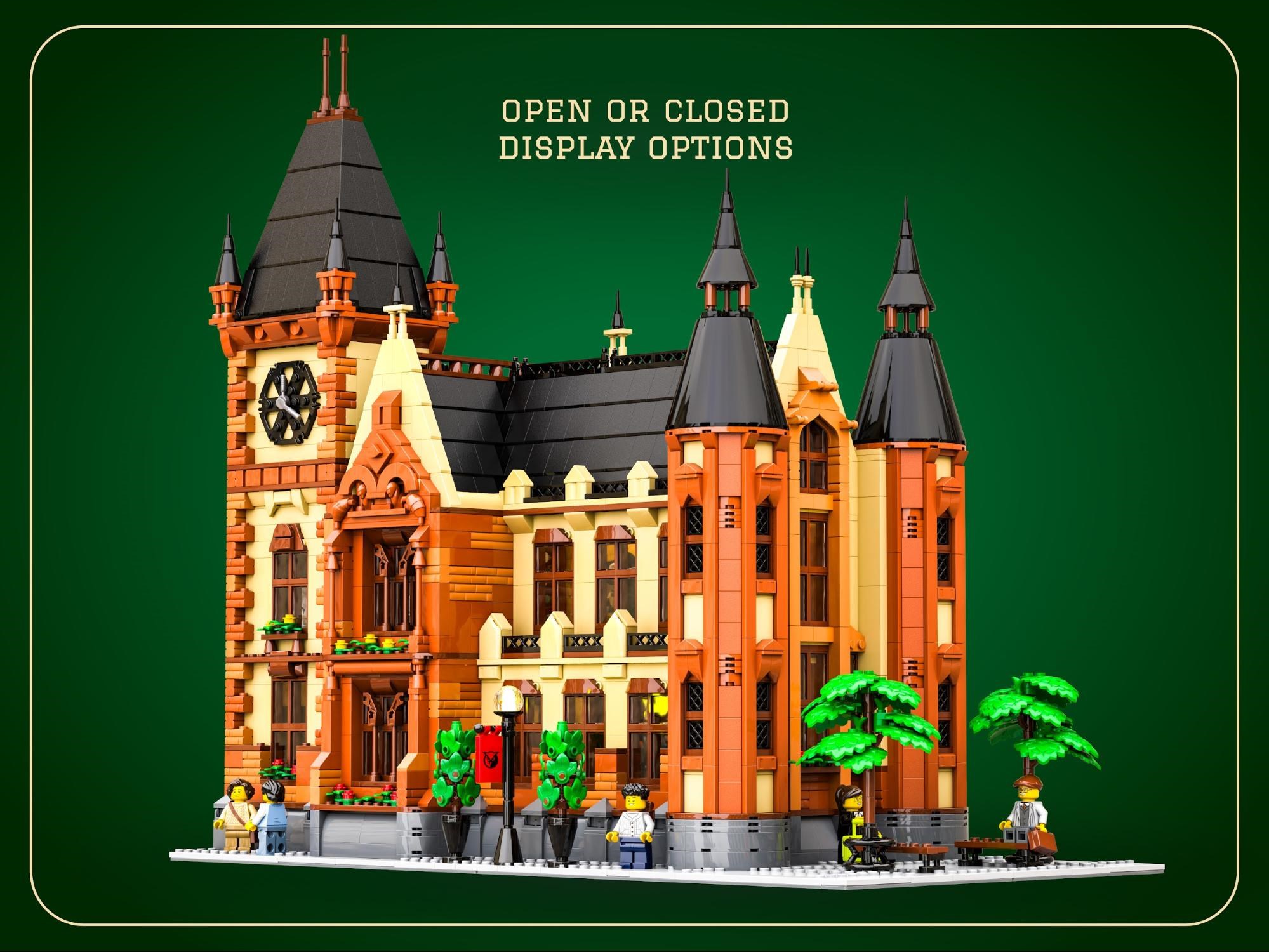
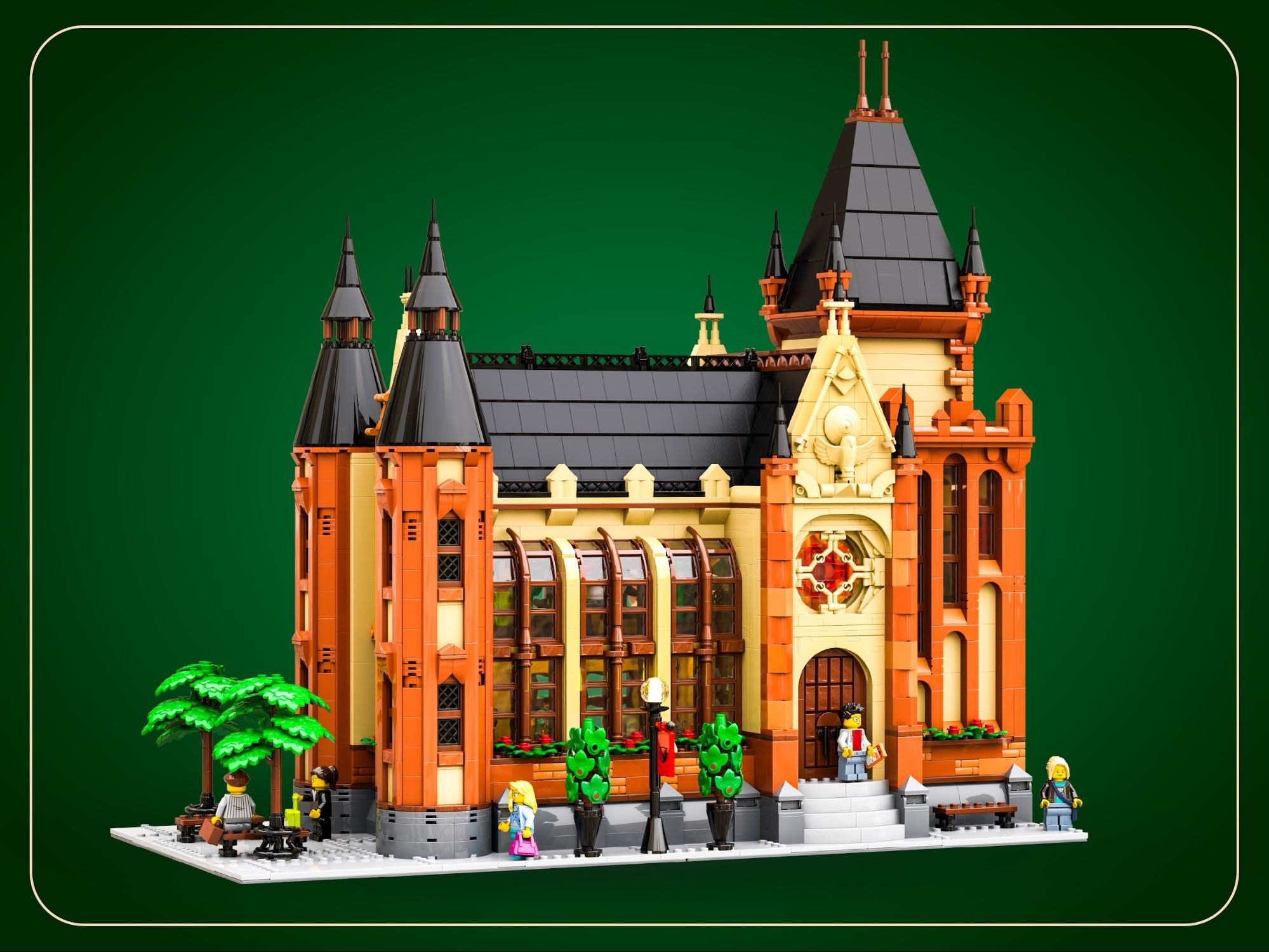
I originally considered having hinges to smoothly open and close both halves, but the connection point of the hinge elements juts out and would have prevented the design from sitting flush next to another building. It also would have made model transportation more difficult, so I settled on a clip and bar connection system.
The architecture of the university was loosely inspired by a variety of universities, cathedrals, and other primarily European buildings. I wanted the colour scheme to be consistent throughout the model, but with such a large building, that could easily make it bland. To combat that, I challenged myself to give each section of the model unique architectural details so that it feels like different sections of a campus. It proved difficult, with essentially every section of the building going through multiple redesigns, but the result proved worth the effort. My personal favourite sections of the building are the entrance, especially the stained-glass window, and the section to its left with the tall, curving windows. Both sections help add unique colours and textures to make the building stand out even more.
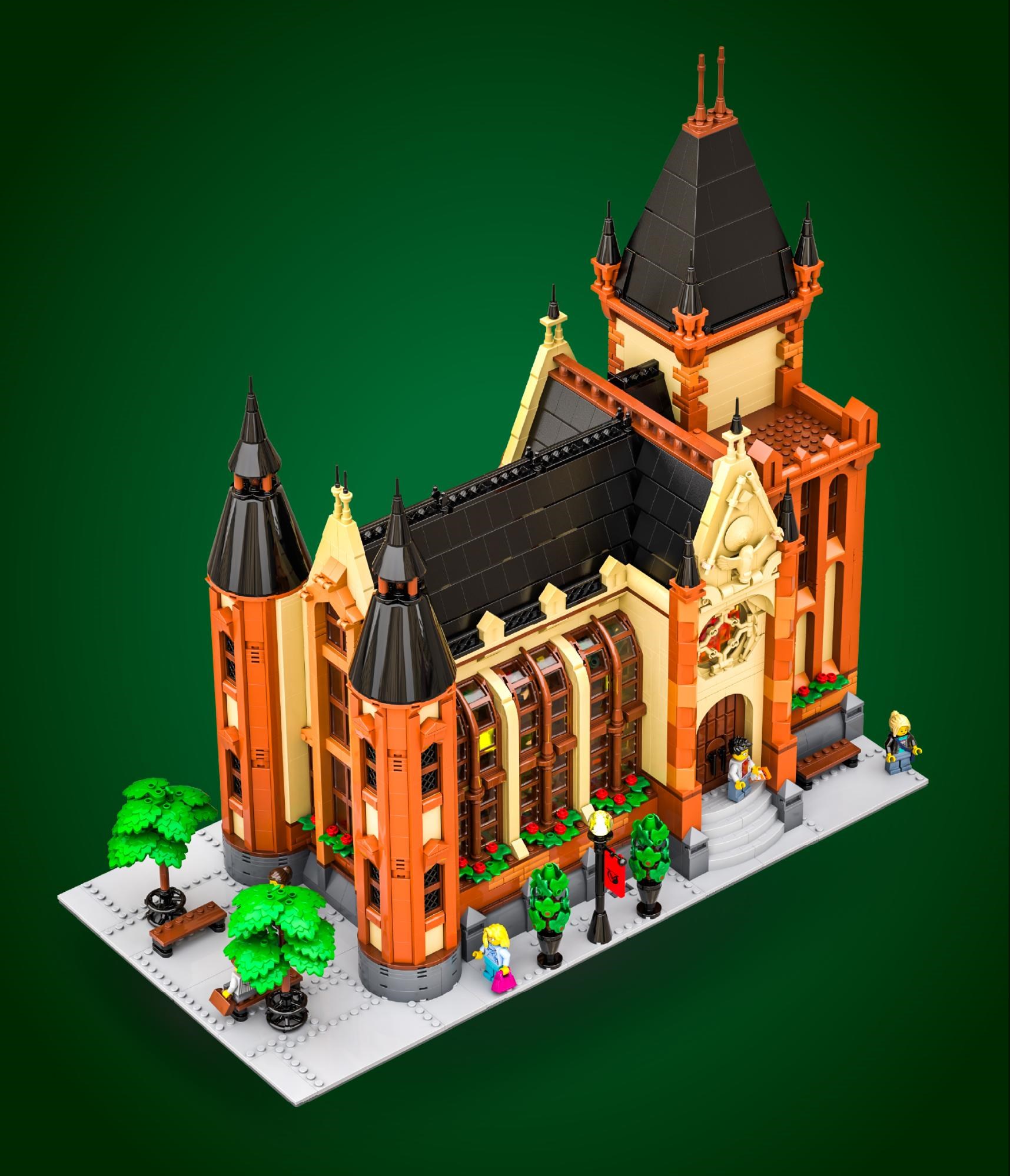
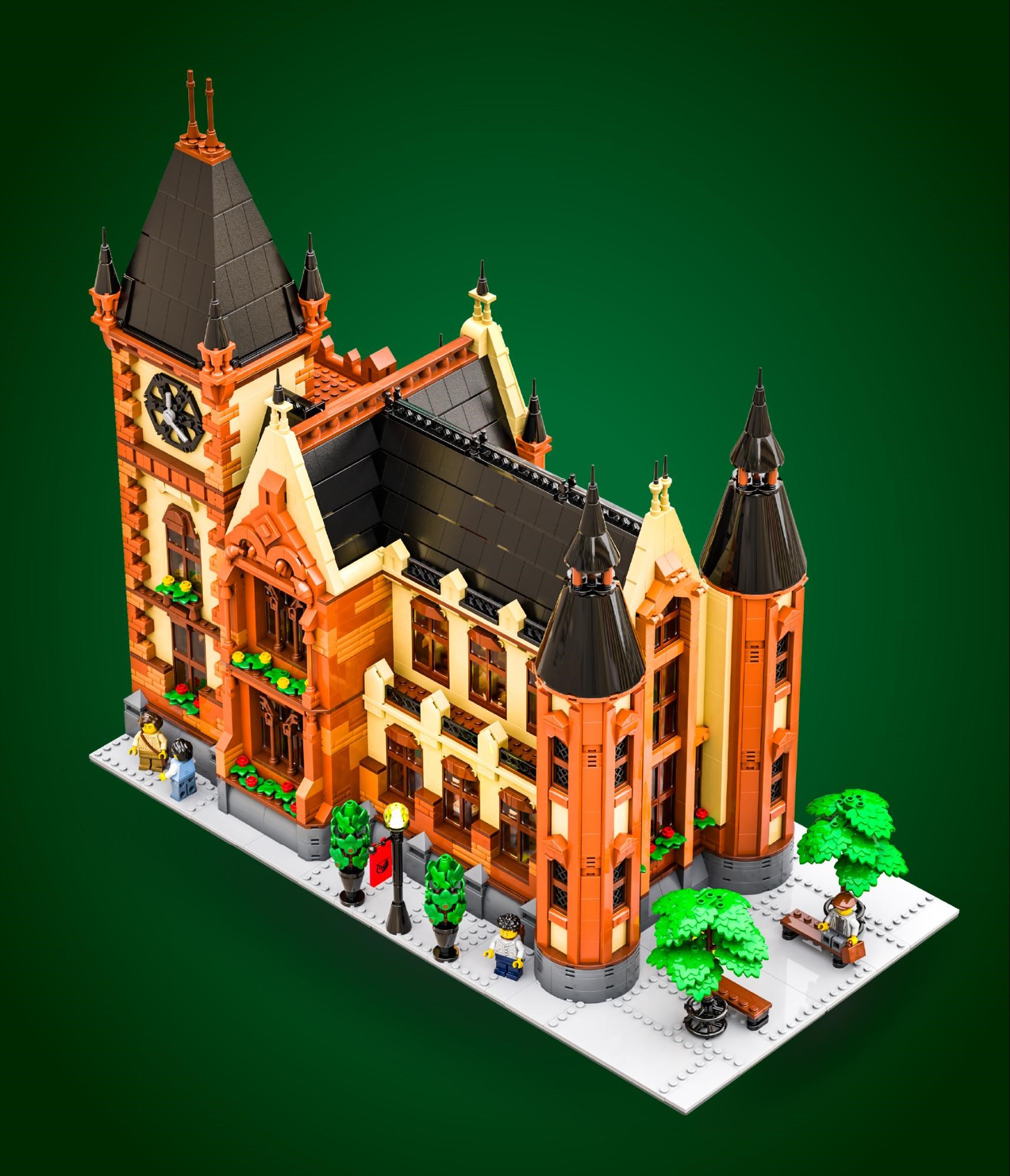
Speaking of the building’s size, I was really happy with how this version of the university captured a sense of the large scale of a campus. In open form, the model is four baseplates wide (128 studs), resulting in a model that’s more than a meter wide (40.3in / 102.4cm). The closed form is more palatable for those wanting to fit it in a city, with a footprint of 32x64 studs, similar to the IDEAS Botanical Garden and twice the size of a typical modular building. It’s no slouch when it comes to height either, maxing out at 18.9in / 48cm, helping it tower over most modulars.
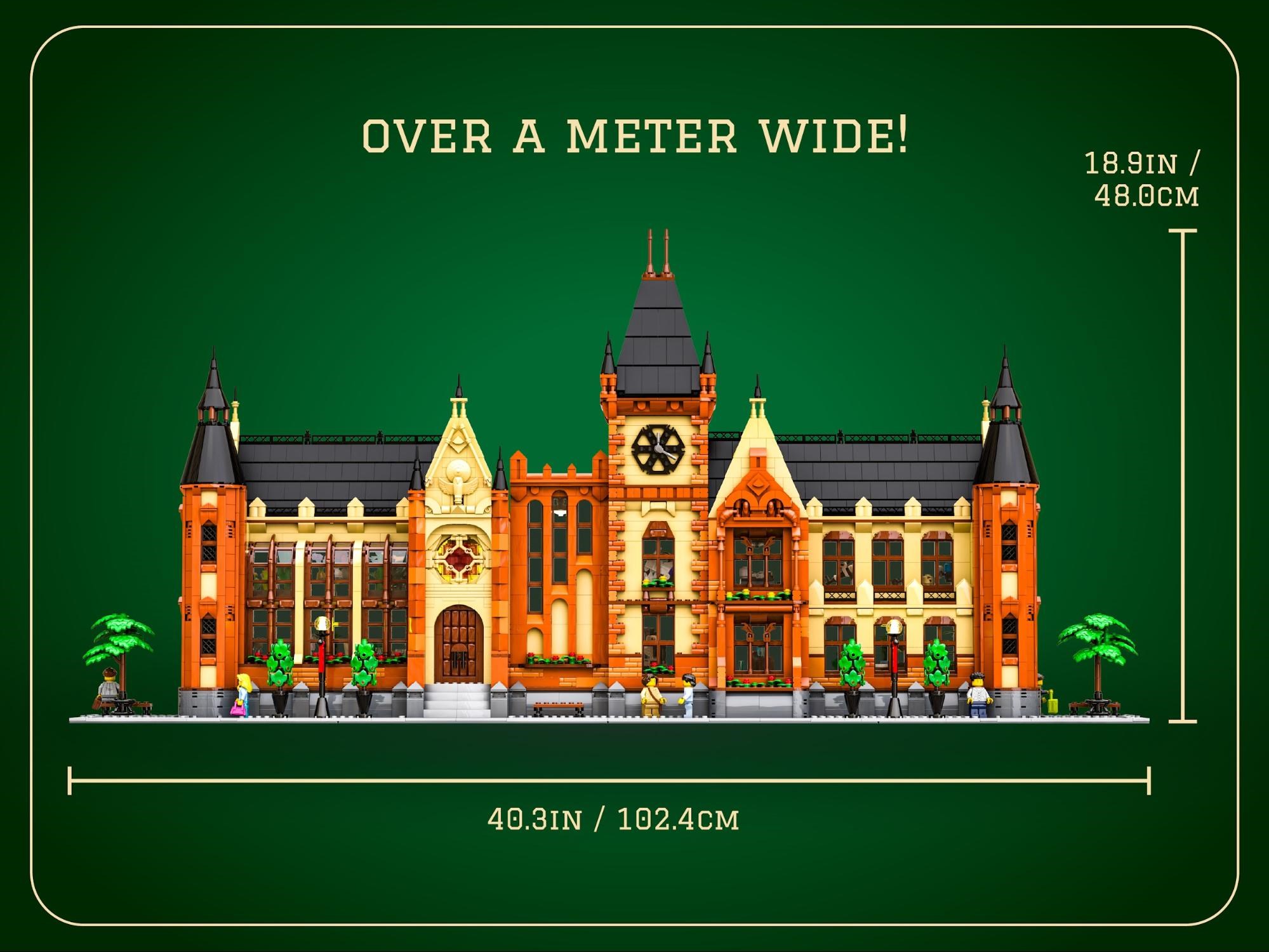
The University of Science
The idea to have the university focus on the sciences began to form during the brainstorming phase of the project. I wanted to tighten the focus in from a general university, both to narrow in what kind of rooms to add in a limited-size project as well as helping differentiate it from the school that I had previously created.
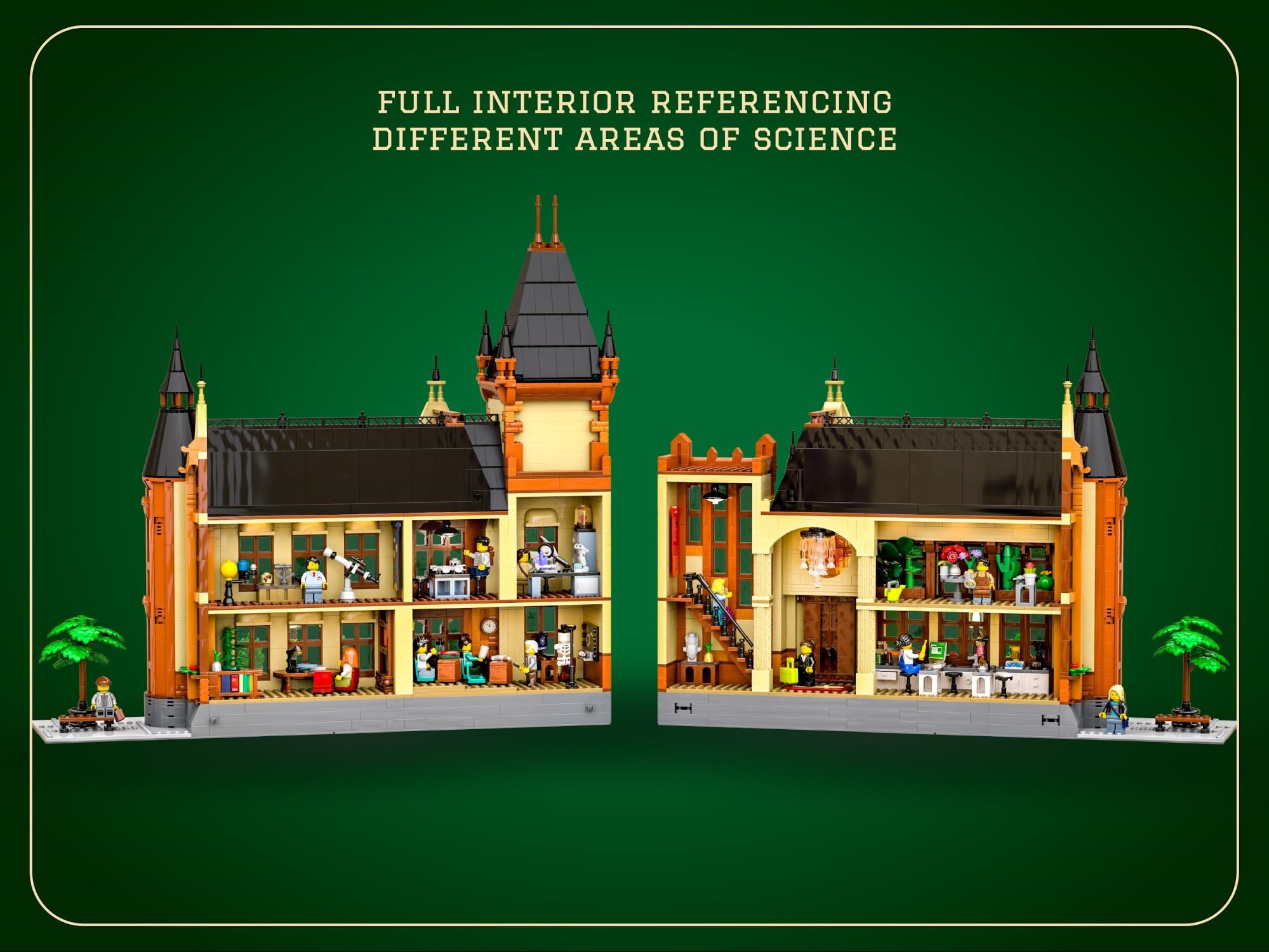
Science also has a wonderful range of fields, which allowed me to design a wider variety of rooms inside of the building. After researching the different fields of science, I narrowed them down to a list that I wanted to focus on. I also decided to mix those rooms with some more “standard” rooms that you would find in a university to best show what the building was supposed to be.
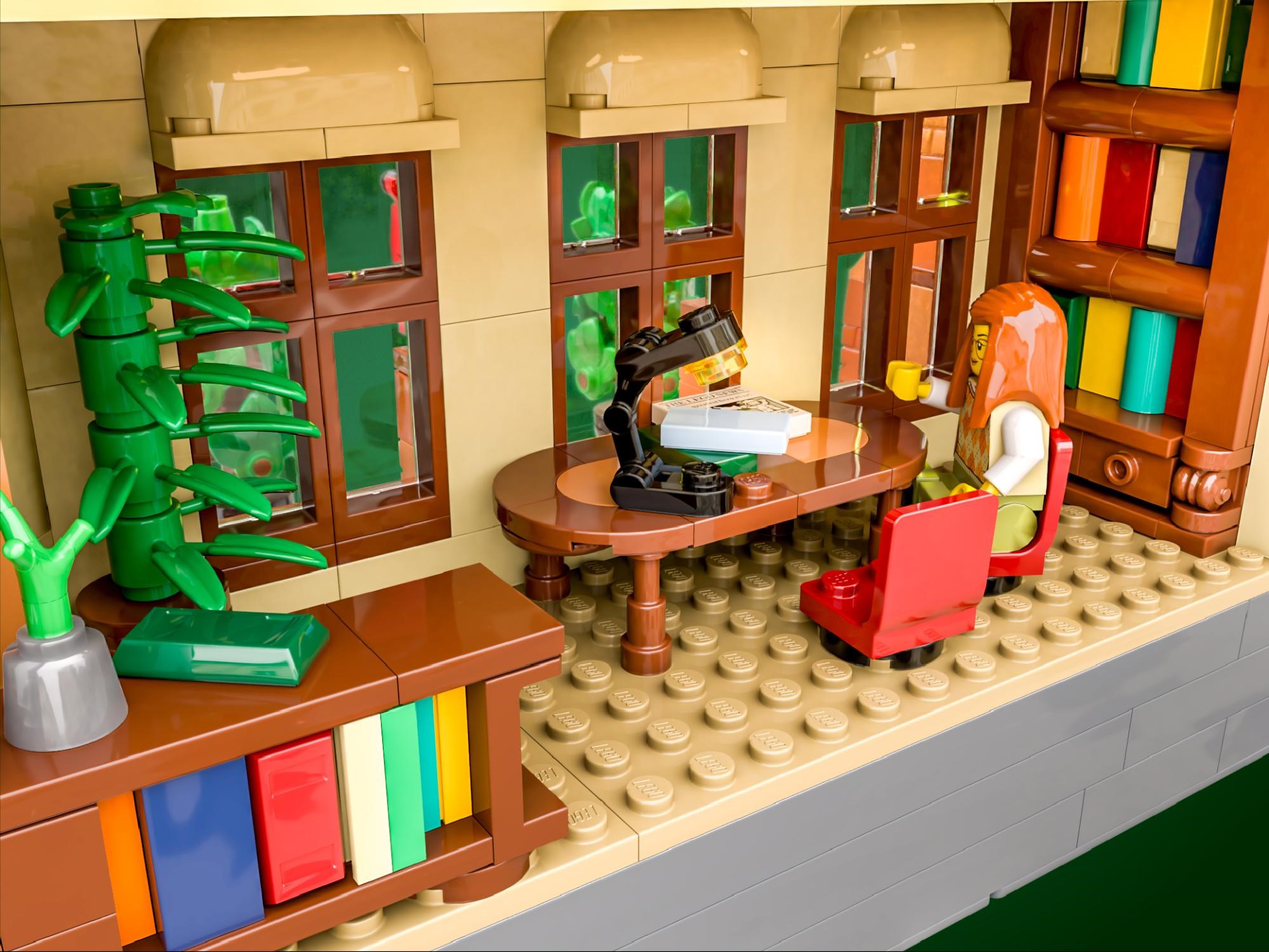
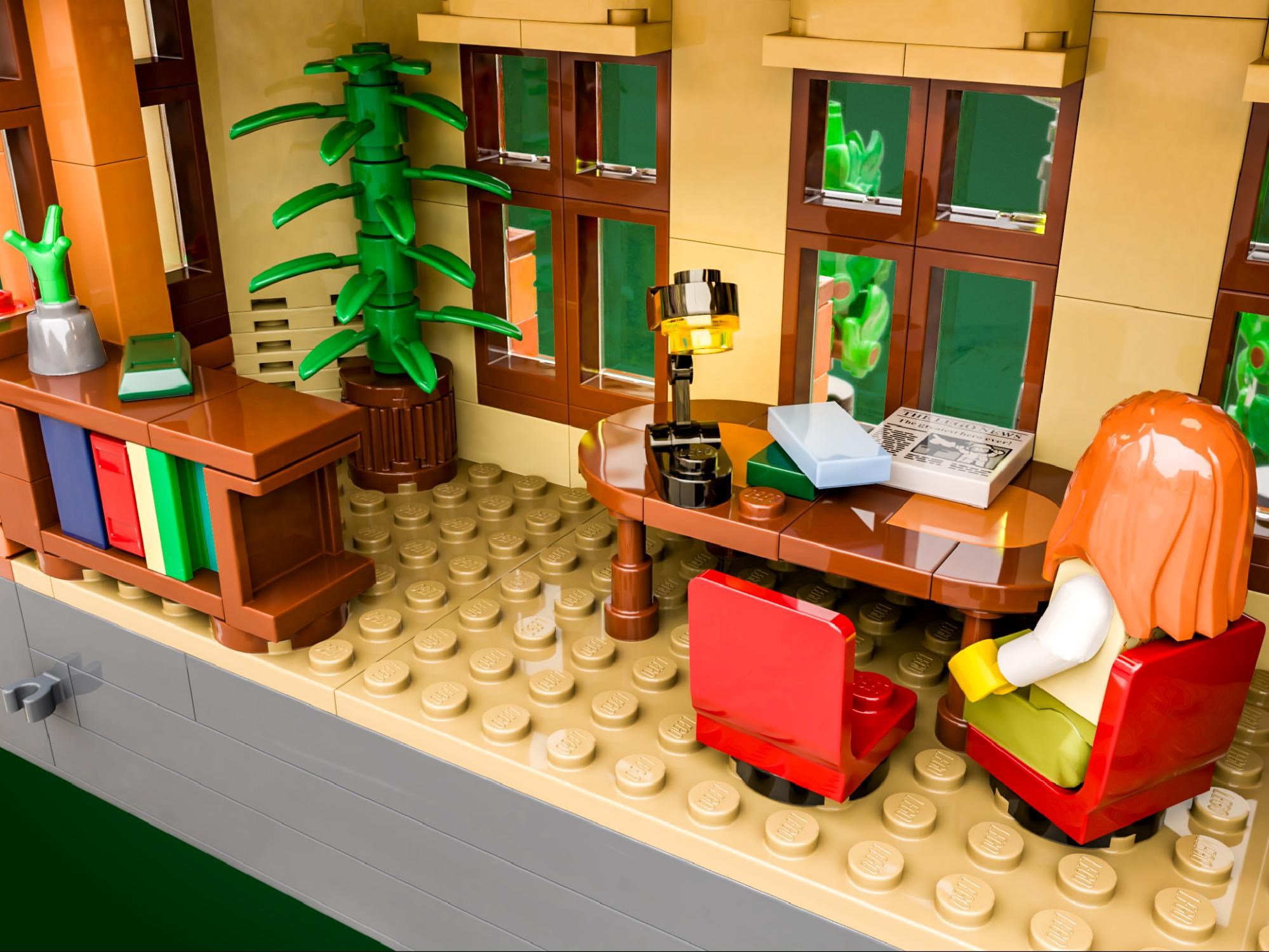
On one left side of the building (when open), the bottom floor features a library and classroom.
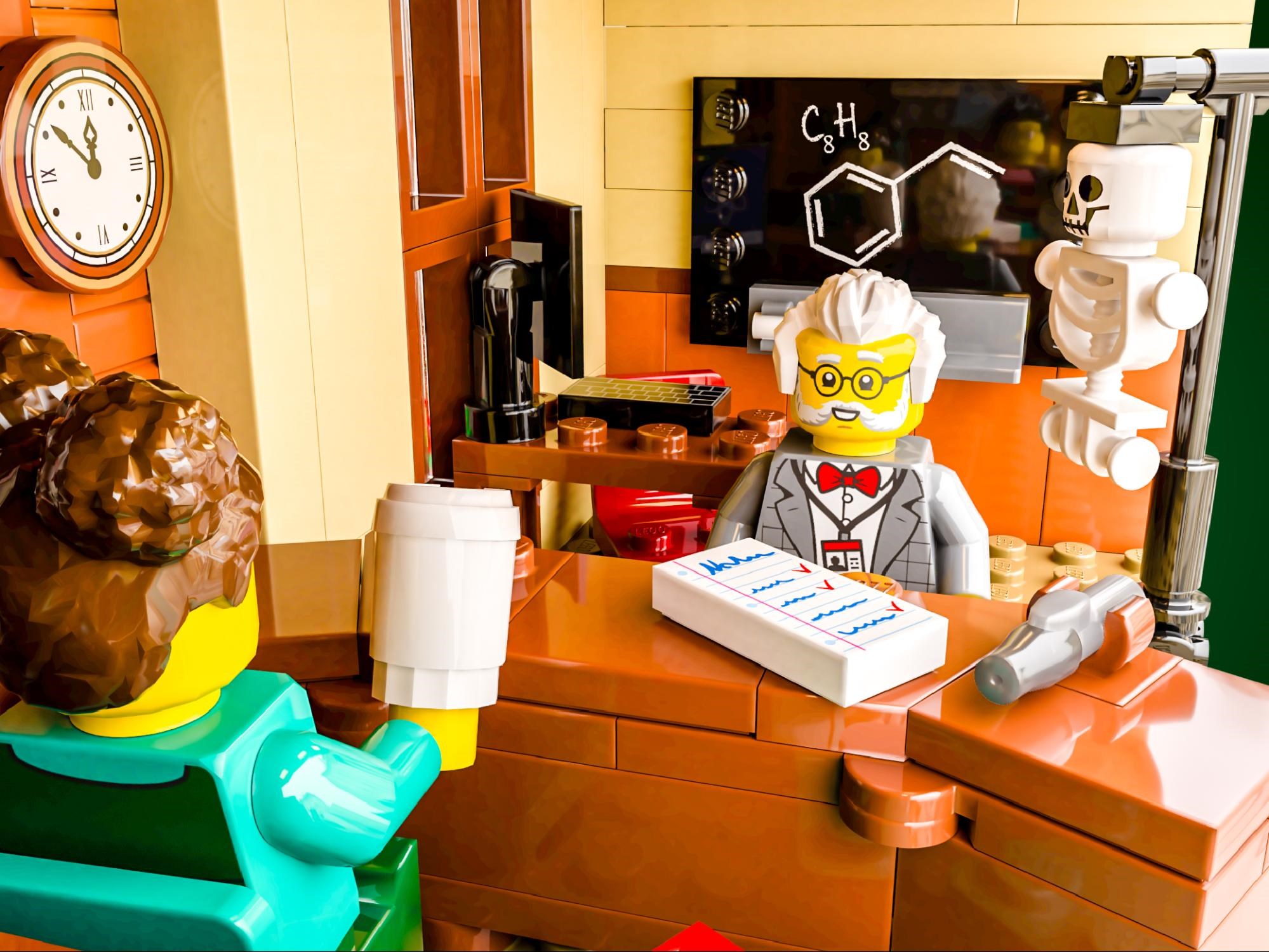
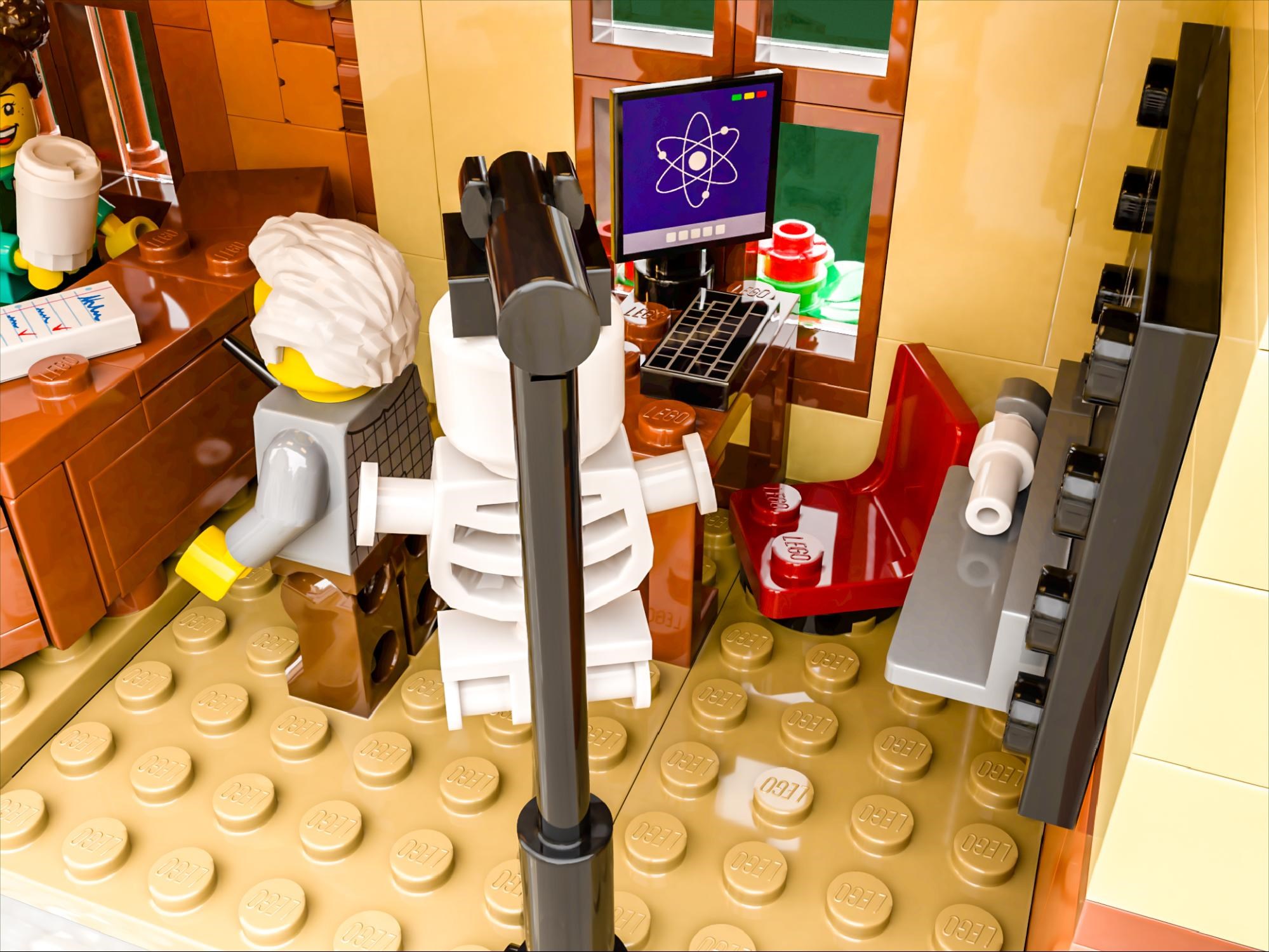
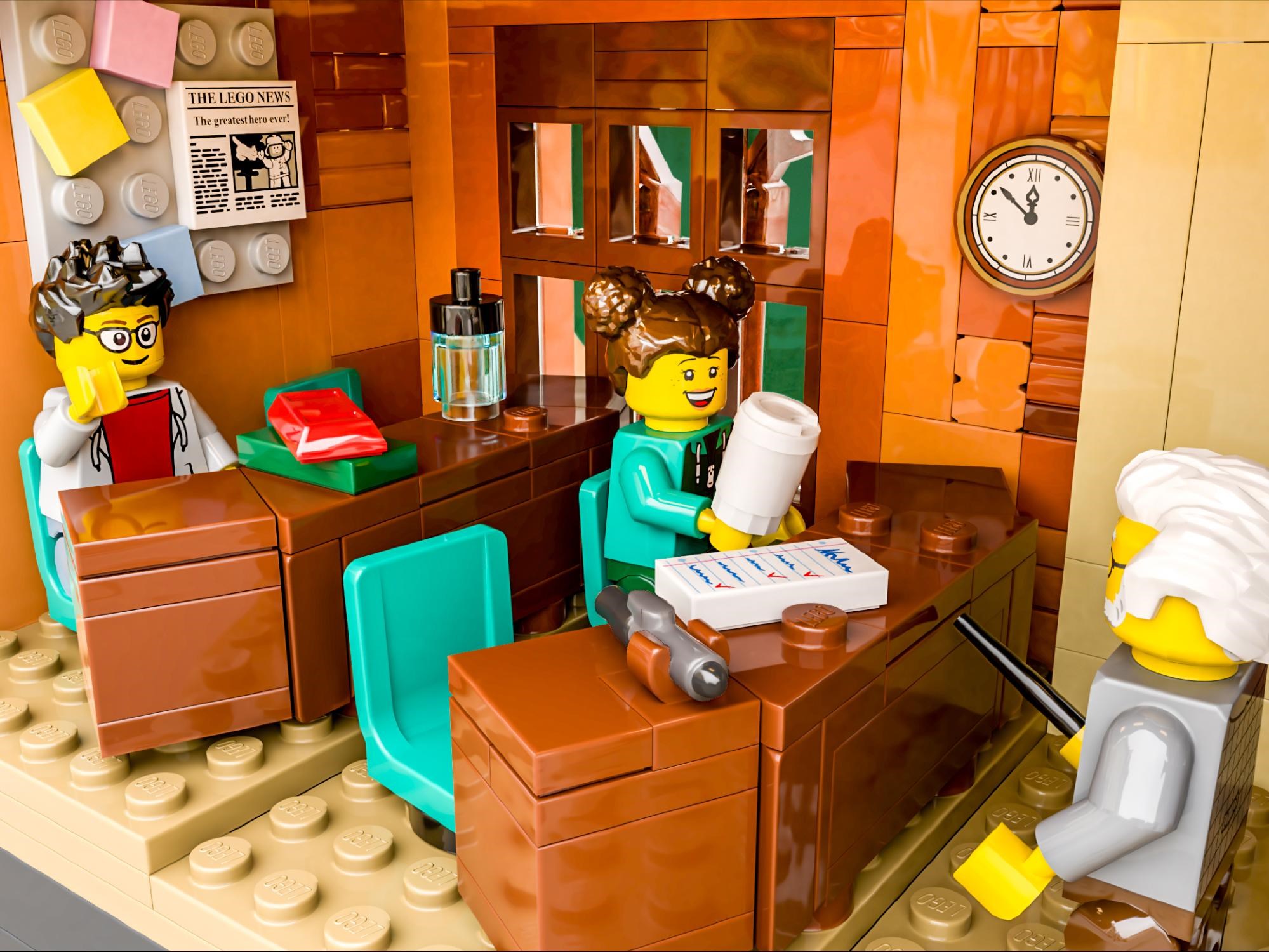
With the classroom, I decided not to focus on one single field of science but instead have references to multiple fields, making it suitable for whatever you want to highlight. The skeleton model references anatomy, while the atom on the desktop background and the blackboard reference chemistry. Fun fact, the C8H8 on the blackboard is styrene, one of the elements of ABS which LEGO bricks are made of!
The left side also includes astronomy with some fun, small builds, as well as a pair of rooms focused on both geology and archaeology.
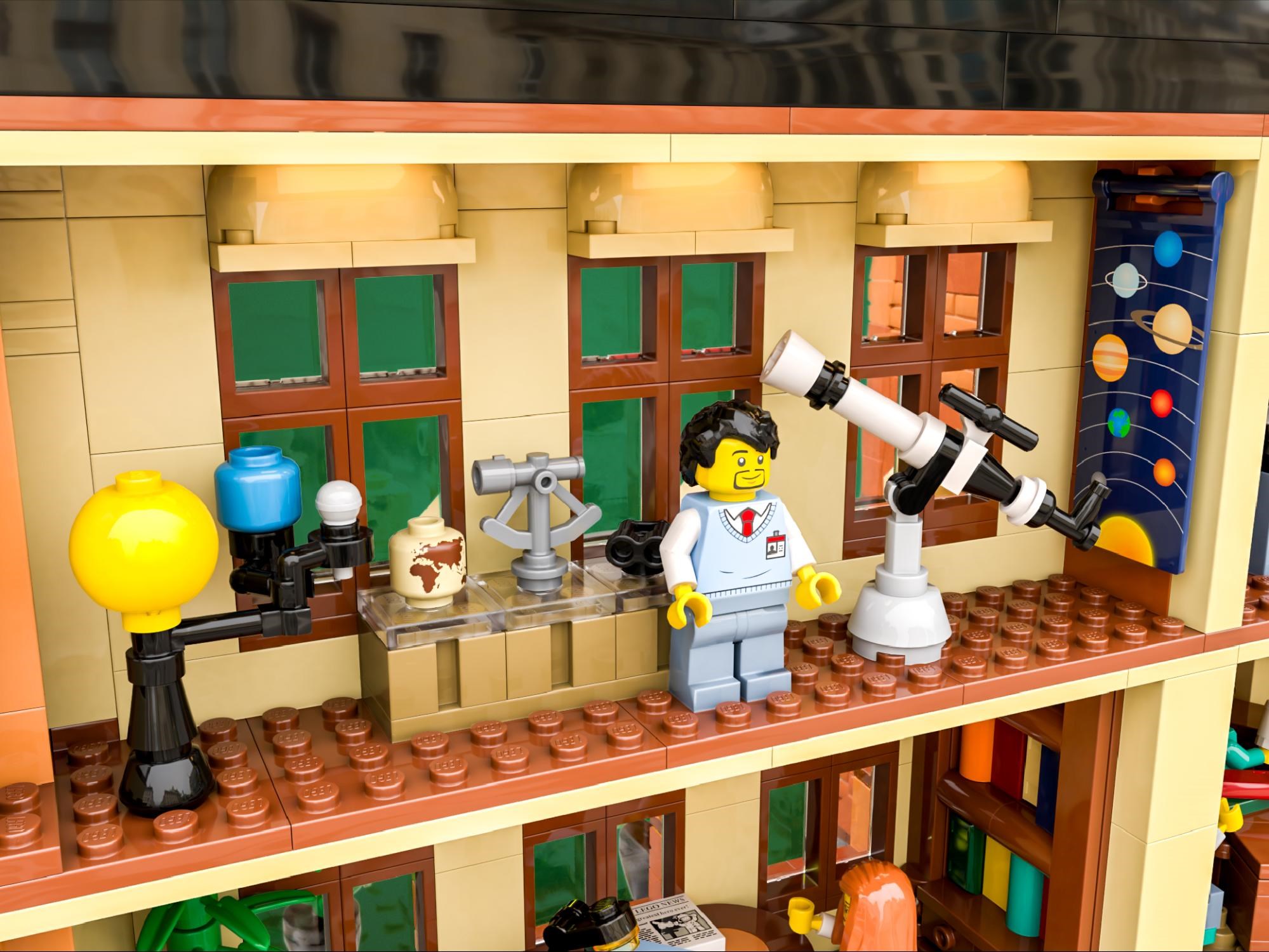
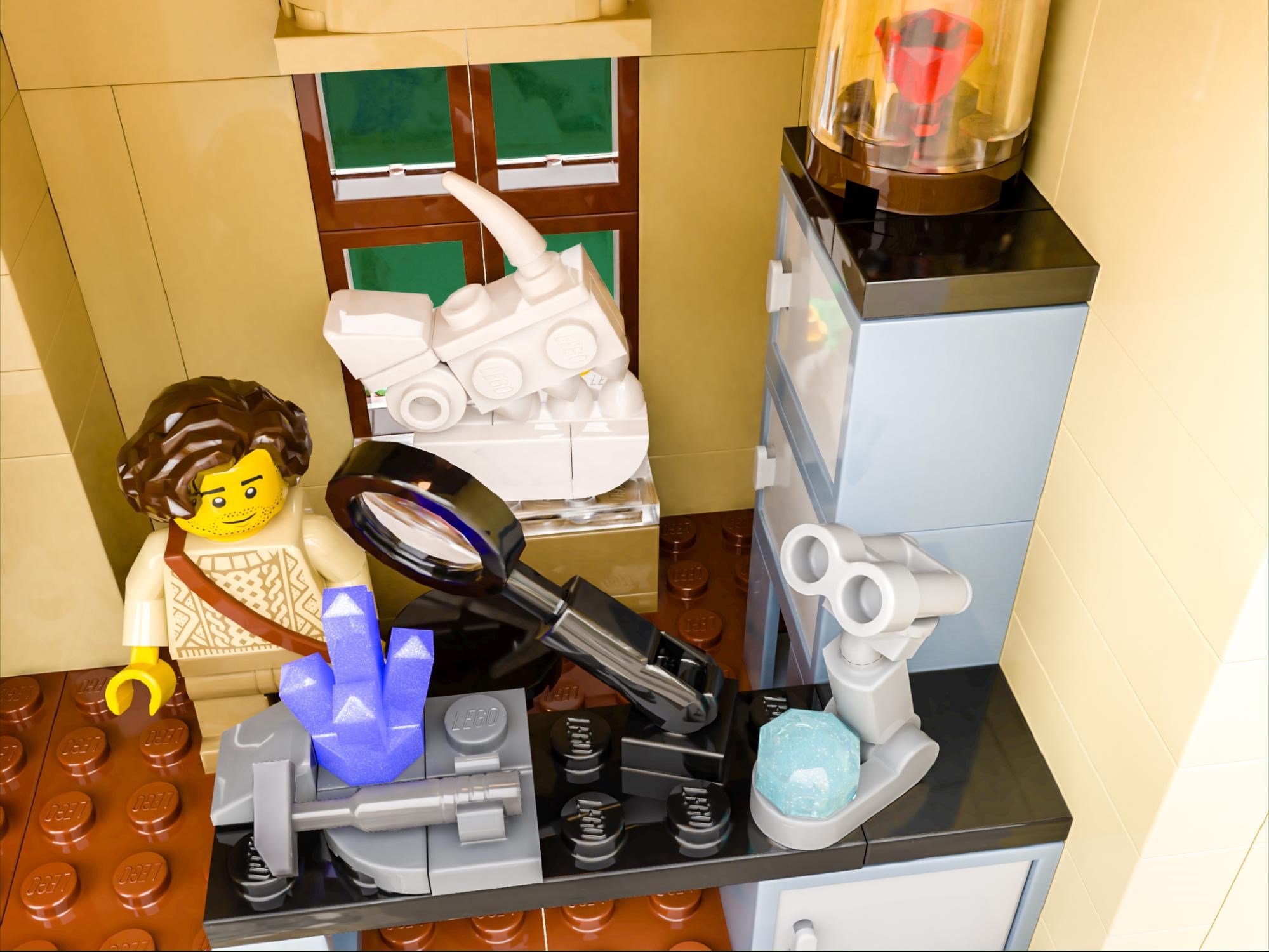
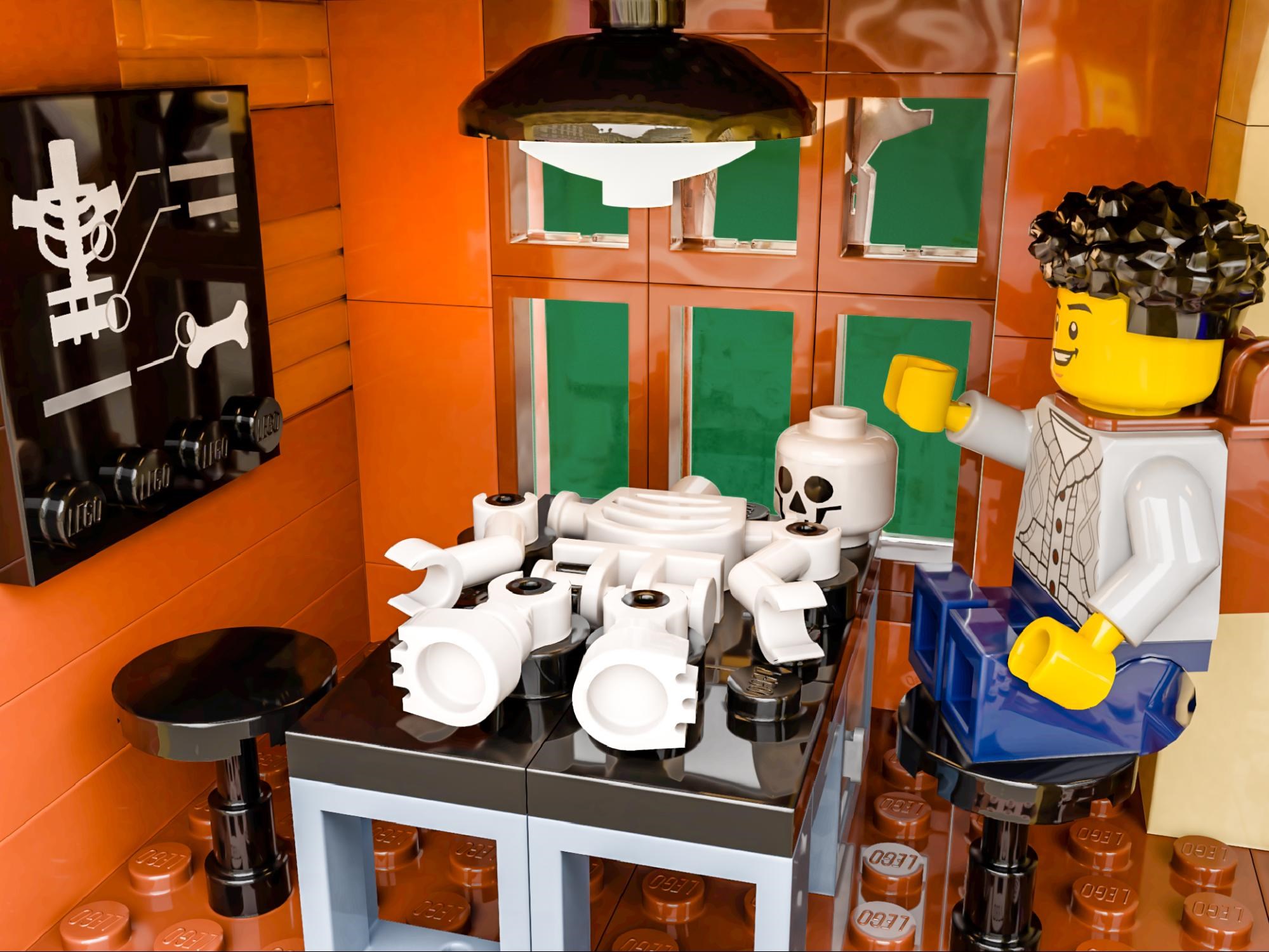
The right side of the building has the entrance with a staircase and chandelier.
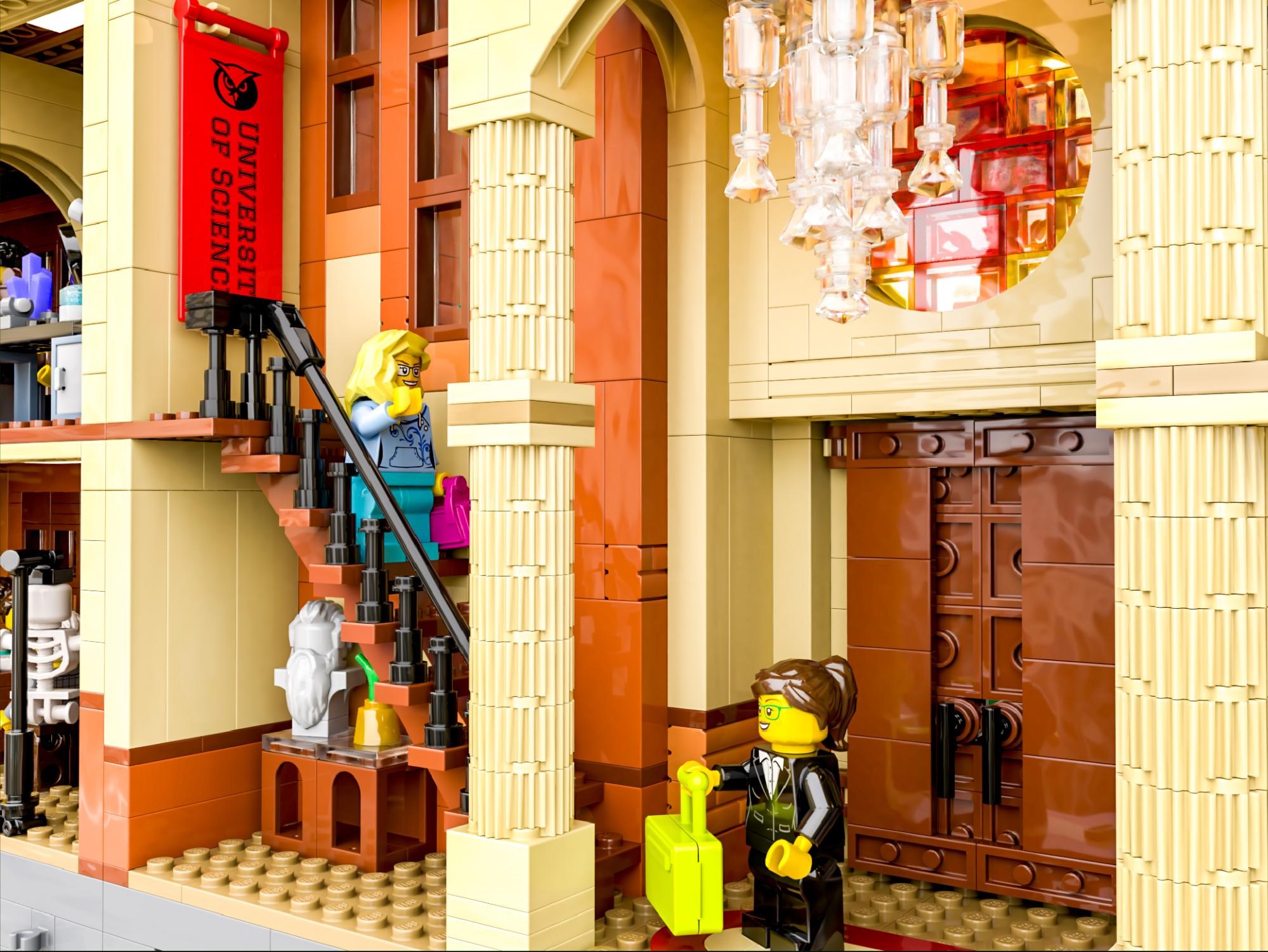
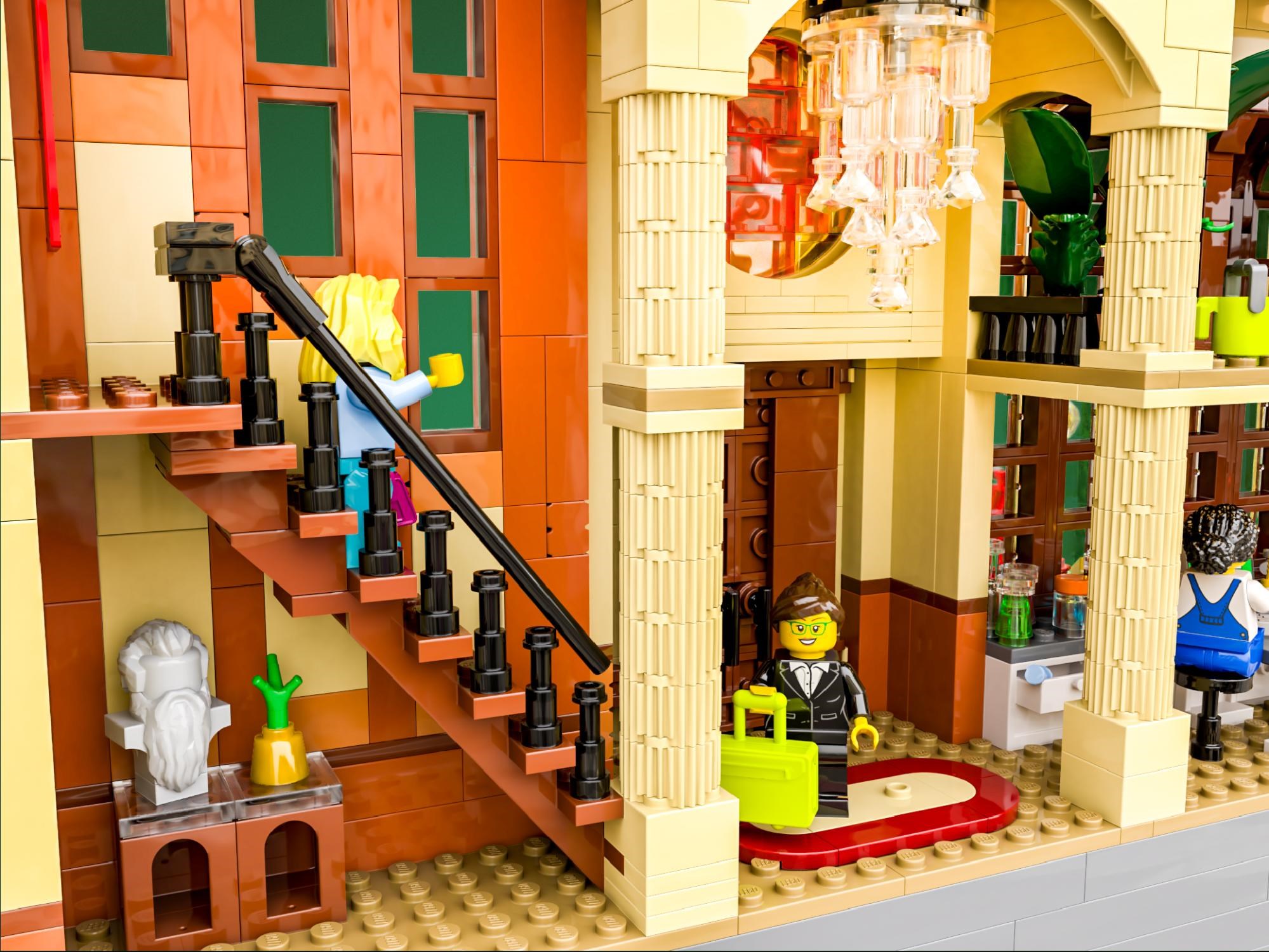
The chemistry lab, an important part of any science building, is featured on the bottom floor with a variety of typical lab equipment.
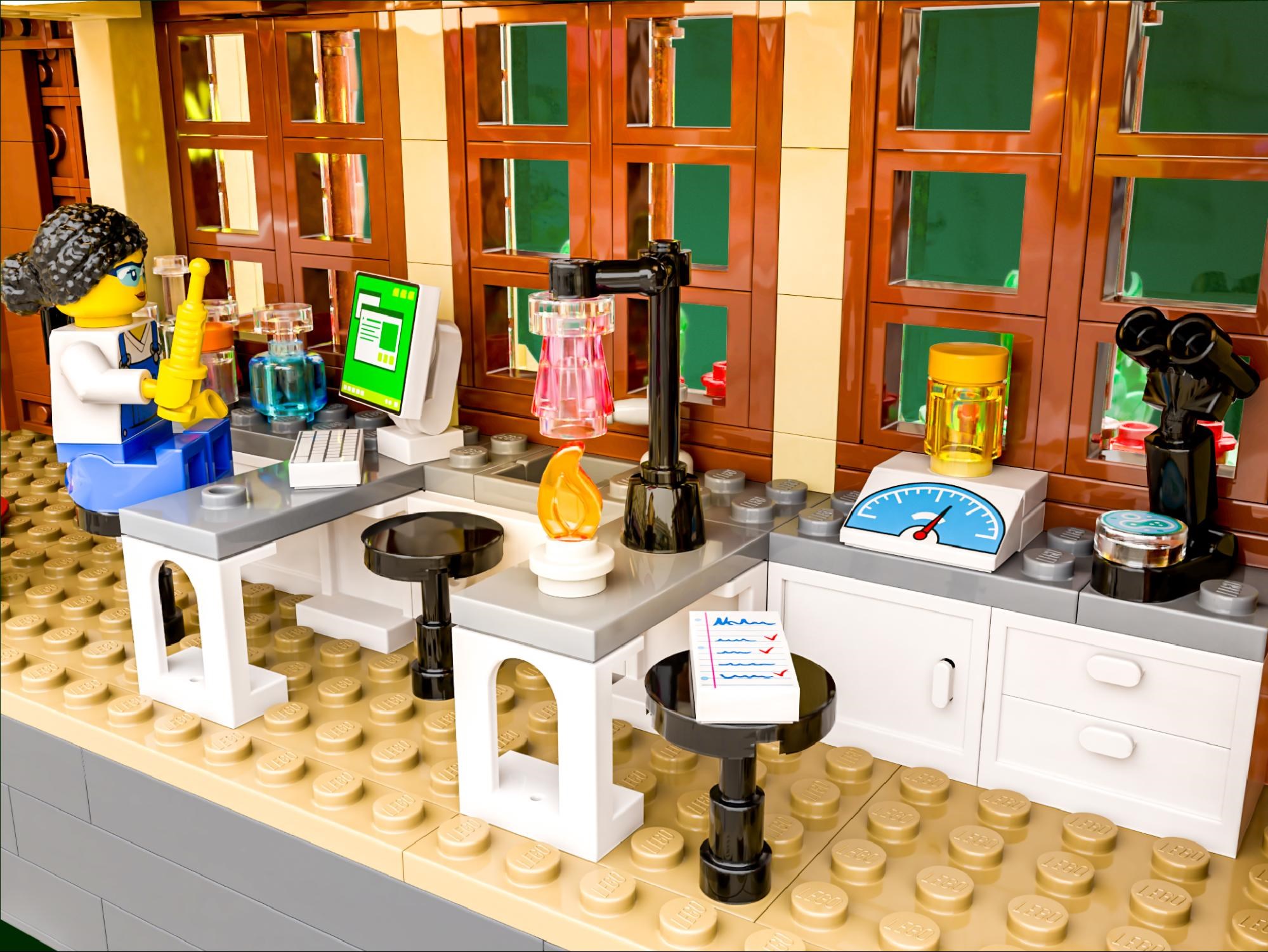
Finally, the top floor is focused on botany, which was a nice way to both add colour to the model and take advantage of the tall, curved windows of the building.
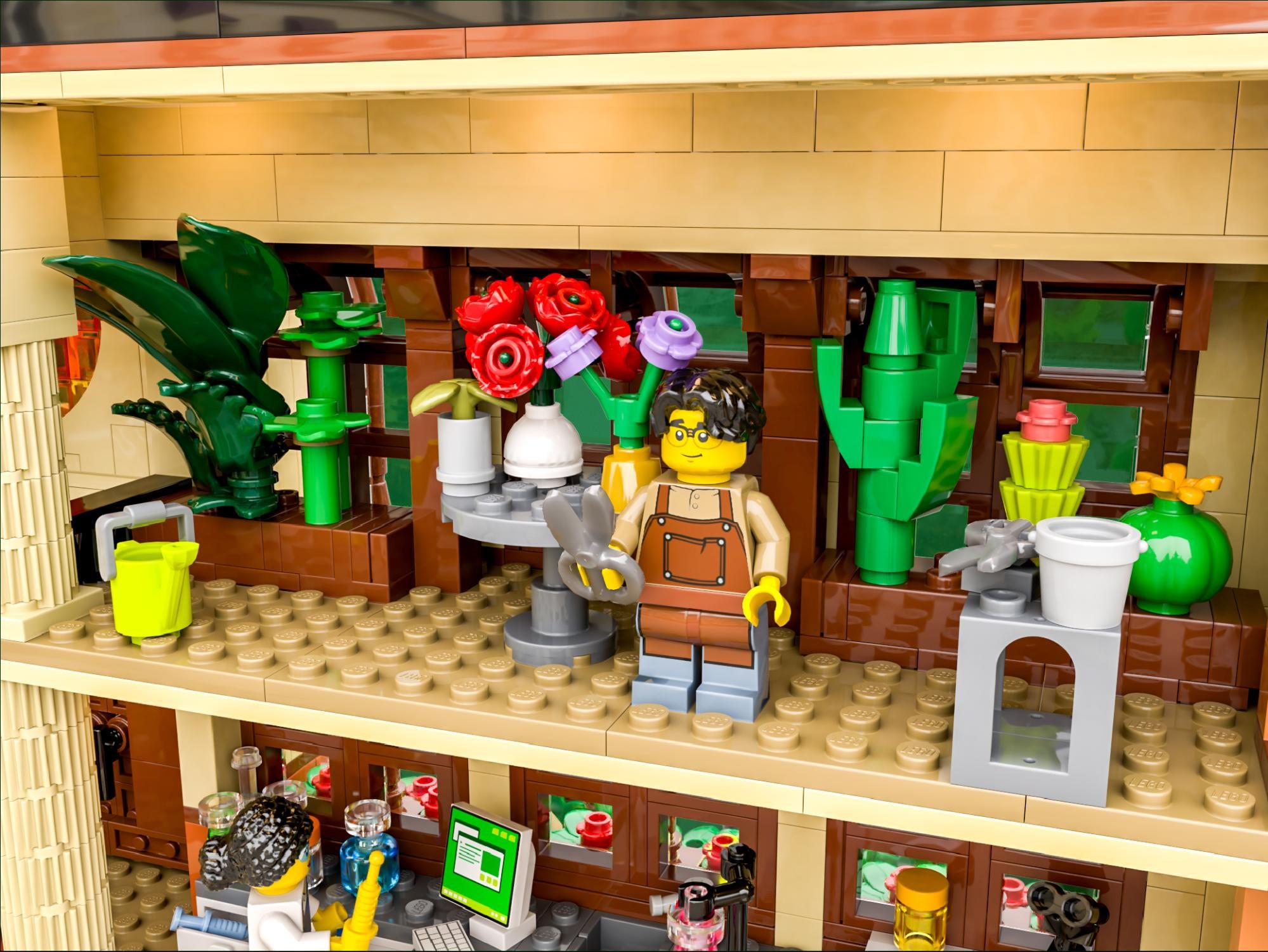
Although the rooms are not comprehensive of all areas of science, I tried to give a taste of many different fields while filling all available space and staying within the part count limit. It was a challenge, but I hope that you can appreciate the result!
The Build
While I don’t want to spoil how everything comes together, I thought I’d end by giving you a glimpse into some of the different submodels of the build.
I wanted to include lampposts with banners, as they are a frequent site around university campuses, at least where I live. The bar of part 87617 worked perfectly to add the banner on the side while allowing the light on top of it, and the microphone element nicely rounded off the banner support assembly.
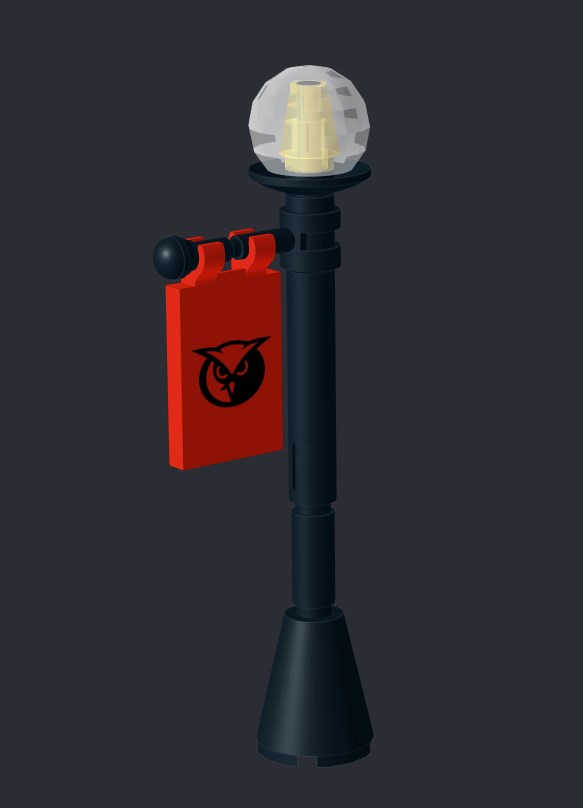
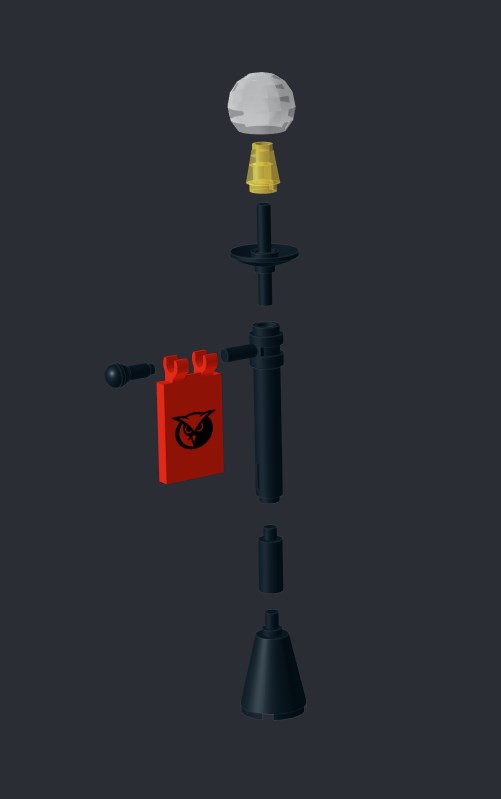
The chandelier inside of the entrance was a fun way to add some detail to the model, taking advantage of the transparent bottle and jewel elements for a staggered hanging effect.
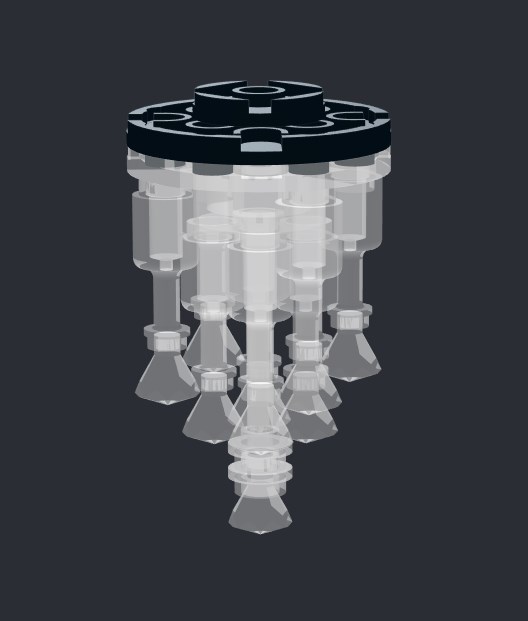
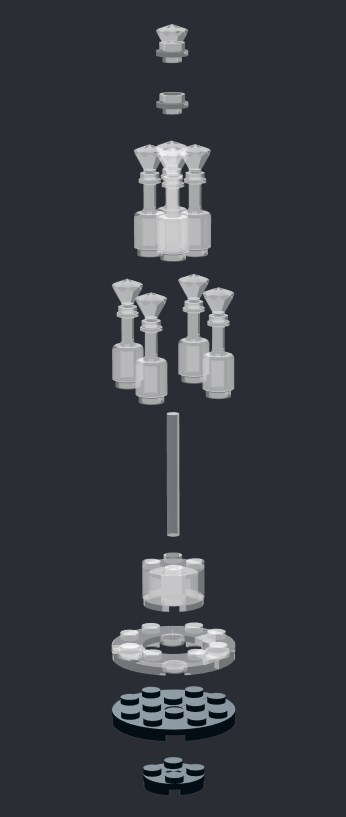
The stained glass window is one of my favourite parts of the model but was also one of the most difficult to design. I experimented with dozens of stained glass designs for months, even before starting to design the university, before settling on the version in the model. Skeleton arms in tan worked great to simulate the framing often found inside of stained-glass windows, while the curve of part 80543 ended up working best for rounding off the window.
Although the part works easily to curve the top of the model, there was no element available to perfectly match the same curve on the bottom. I used stud reversal techniques to use the same part upside down for the best possible shaping. Here’s a look at some of the subassemblies that resulted -
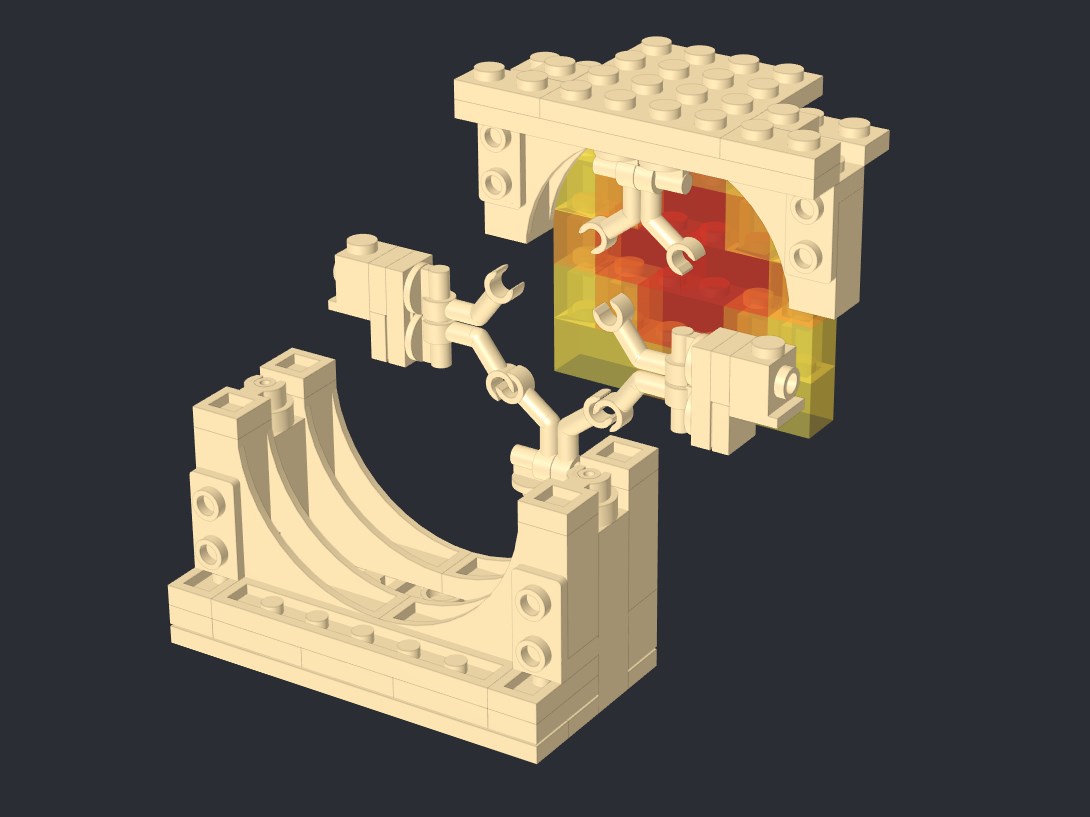
Finally, I tried to use a nice variety of elements on the exterior to achieve a variety in texture. Dark orange was especially challenging with limited elements available, but parts like the goblet (6269) and the croissant (67338) helped, and see if you can spot my favourite part usage, the squirrel (98480).
Master Wu’s hat makes an appearance above the owl (67632), an element whose introduction in tan inspired the owl mascot of the university and can be found on banners throughout the model. It was also a logical connection considering the frequent association of owls with education.
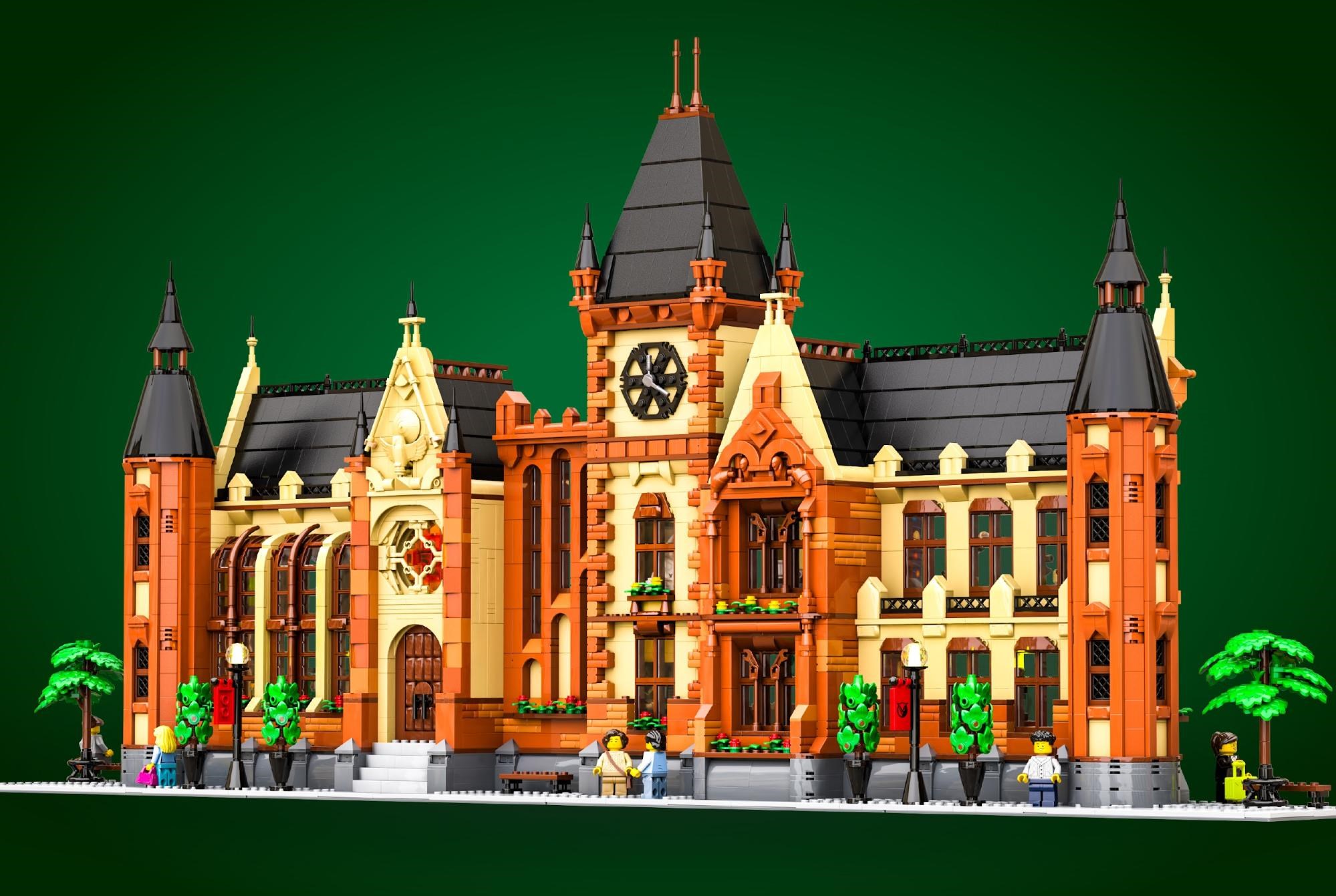
Thanks for reading, if you are interested in voting for the model, that would be greatly appreciated! Comments and feedback are also welcome, and I’ll try to respond to any questions in the comments! Vote for the University of Science here
Also, feel free to take a look at my other BDP Series 8 submissions -
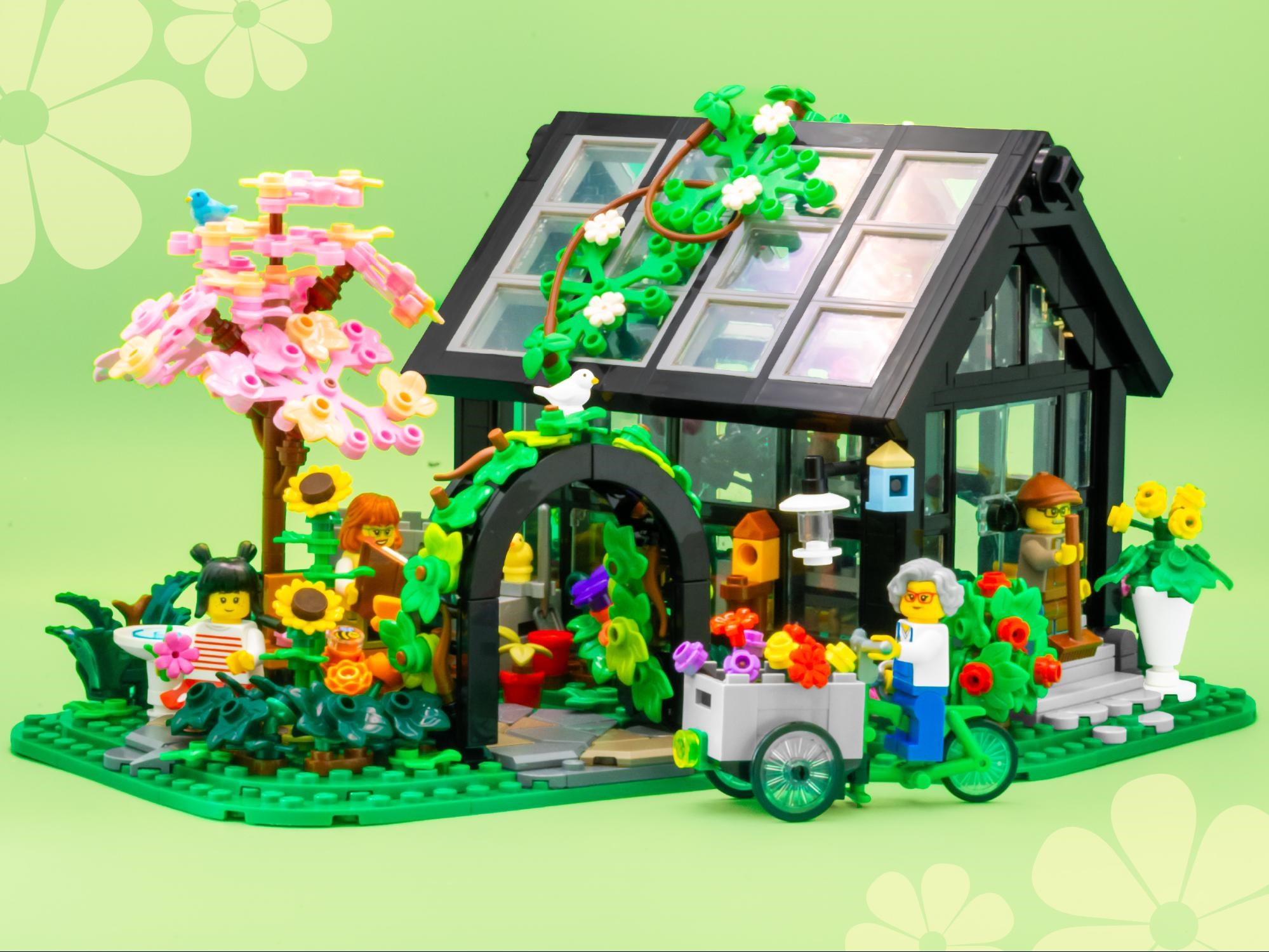
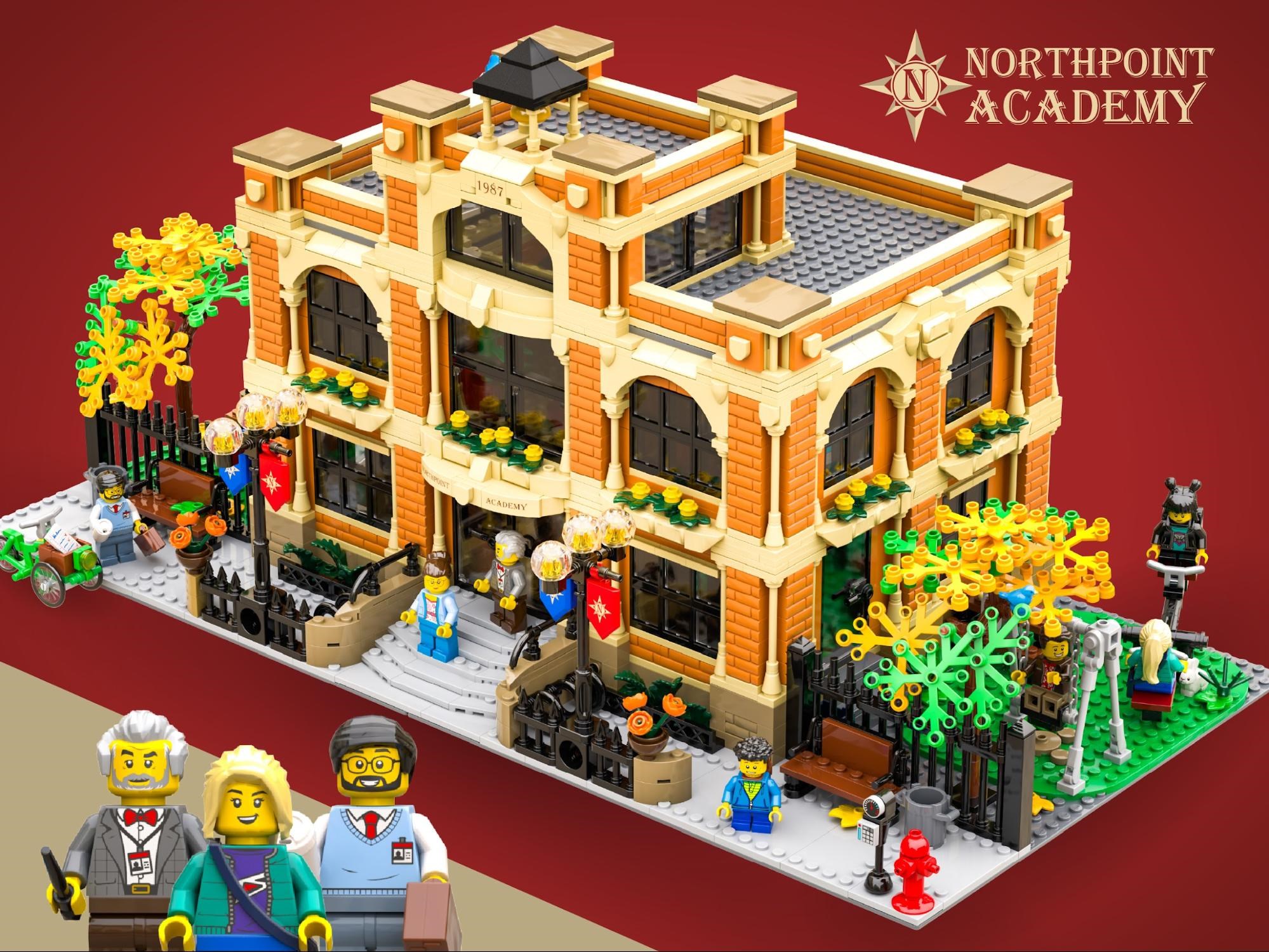
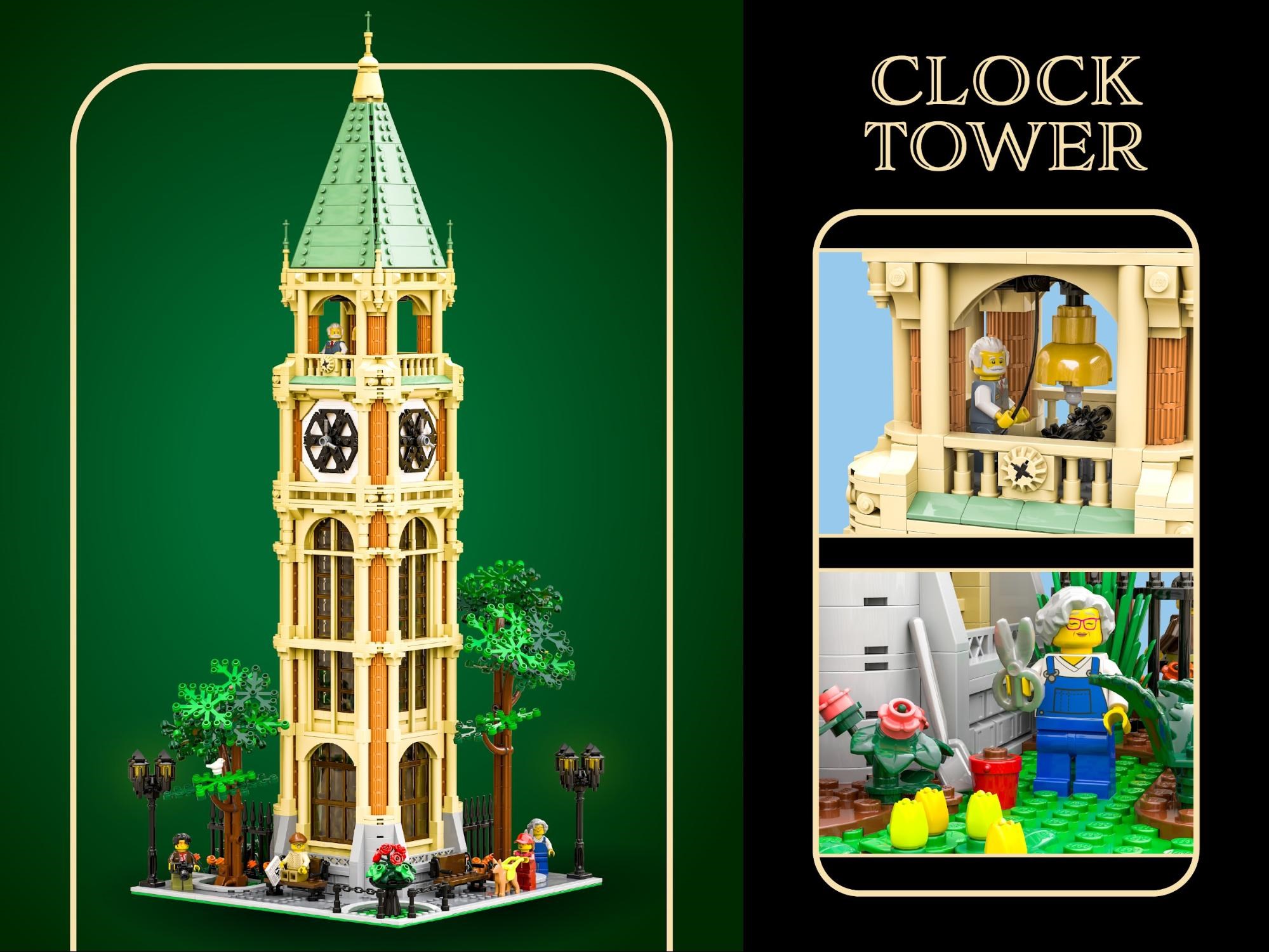
85 likes
31 comments on this article
That old Norm MacDonald joke gets to have a set of this size?
This looks an awful lot like a church and I like that. It reminds me on an moc rebrick of the Hogwarts set, that made me buy it, just so I could build the moc, not being a HP fan.
@daniellesa said:
"This looks an awful lot like a church and I like that. It reminds me on an moc rebrick of the Hogwarts set, that made me buy it, just so I could build the moc, not being a HP fan."
It reminds me of some of the Oxford colleges.
Impressive. It too reminds me of Hogwarts.
It looks like the Schloss Drachenburg from Germany. Cool model!
I really hope this one makes it this time! Please go vote people!
Amazing article and build! Love that our stained glass “rose” window techniques are similar but yet different.
Amazing images - is this rendered in Blender?
No Physics section?
@wwward said:
"I really hope this one makes it this time! Please go vote people! "
Much appreciated, I hope so too!
@arselus said:
"Amazing article and build! Love that our stained glass “rose” window techniques are similar but yet different.
Amazing images - is this rendered in Blender?"
Thanks! It's been fun watching your model evolve, I didn't realize how much our stained glass windows had in common, that's awesome. The images are rendered in studio but edited with a substantial amount of time haha.
Nice build. Love it. Can't see squirrels.....unless they are next to croissants?
Despite the incredible designs found in the Bricklink Designer Program (BDP), I do not buy those (at least, as of now) because they do not have printed building instructions. As such, I would definitely prefer that this model make it through the Ideas process (I suppose the rules are a bit different). This is an outstanding model and I would definitely get that as an idea set. Best of luck with your project.
@MandoEli37 said:
"No Physics section?"
Physics is one of the areas that I would have liked to include, but it didn't have enough standout builds to include as opposed to some of the other areas of science. If selected, I'll think about what else I can include. Some alternate stickers for the blackboard referencing different sciences is an idea I just thought about that could help with that.
@beatnik said:
"Nice build. Love it. Can't see squirrels.....unless they are next to croissants?"
Good eye! They are indeed close by the croissants, you can see the tails of them. :)
@HOBBES said:
"Despite the incredible designs found in the Bricklink Designer Program (BDP), I do not buy those (at least, as of now) because they do not have printed building instructions. As such, I would definitely prefer that this model make it through the Ideas process (I suppose the rules are a bit different). This is an outstanding model and I would definitely get that as an idea set. Best of luck with your project."
Thank you! I definitely understand your point and plan on potentially submitting to Ideas in the future if it doesn't find success in BDP. I suspect that the model would be a bit too niche to find enough success in Ideas, but it's certainly on my mind! I understand your dislike of digital-only instructions, I prefer physical as well, but in my experiences the digital haven't bothered me too much.
@Aragosta said:
"That old Norm MacDonald joke gets to have a set of this size?"
That was my first thought! Gonna have to add a Logic classroom and a Norm figure lol
@daniellesa said:
"This looks an awful lot like a church and I like that. It reminds me on an moc rebrick of the Hogwarts set, that made me buy it, just so I could build the moc, not being a HP fan."
The similarities between European ecclesiastical and educational architecture are, of course, no coincidence. Historically, schools and universities were also seminaries and students had to have at least some training in theology. Until the first half of the 20th century, all undergrads at Oxford for example had to pass an exam in ‘Divinity’, and it’s still the case today that they’re giving a Christian blessing as part of their graduation ceremony (unless they opt out).
@Aragosta said:
"That old Norm MacDonald joke gets to have a set of this size?"
YES! I need a Professor of Logic minifig. Along with 2 minifigures, one with a doghouse and one without! ;)
I loved picking up the Science Tower (BL19007) and this looks great too.
Exquisite exterior details.
Although, I'd love to see more science experiments/references outside and within, devices, etc.
The room in the lower left (library) when opened, there's more space there to add in some more SCIENCE!
Maybe outside on the grounds with tiles, add in the pythagorean theorem.
I did that with my Science Tower when trying to expand its grounds around the building.
" @KingCreations
@MandoEli37 said:
"No Physics section?"
Physics is one of the areas that I would have liked to include, but it didn't have enough standout builds to include as opposed to some of the other areas of science. If selected, I'll think about what else I can include. Some alternate stickers for the blackboard referencing different sciences is an idea I just thought about that could help with that."
Maybe like the Science Tower add in a Double-Slit Experiment?
@legoDad42 said:
"I loved picking up the Science Tower (BL19007) and this looks great too.
Exquisite exterior details.
Although, I'd love to see more science experiments/references outside and within, devices, etc.
The room in the lower left (library) when opened, there's more space there to add in some more SCIENCE!
Maybe outside on the grounds with tiles, add in the pythagorean theorem.
I did that with my Science Tower when trying to expand its grounds around the building."
Thanks for the feedback! Part count was honestly the limiting factor for how much I could add to the interior, but you make a great point, I'll definitely consider adding details along those lines.
Very nice! What a great build! Terrific techniques.
Lovely build. I'd definitely buy this!
Brilliant looking building. Gives me a lot of nostalgia for the school I went to 50 years ago, right down to the owl on my blazer! I hope it gets through.
gorgeous!
Those are all fantastic submissions. I don't think I could pass up any of them. My favorite is the focus of this article.
I'm really impressed with the architectural detail, minifig compatibility, and 360 degree display value. Those are crucial to my purchasing decisions- as well as compatibility with my displays. All of these would work well.
Good luck!
I don’t know which one I like best. Excellent work and presentation.
It’s a very neat build & I wish you good luck.
I am still sad your Woodland Sanctuary didn’t get through; it is probably still my favourite of all your builds and I’d buy the instructions in a heartbeat.
"university of science" as opposed to University of???
Nice work.
But being of a stick in the mud, "University of Science" is - weird. Unless you have an entire Town called Science, at least! Especially given the (very appealing) European style of building.
@sgllama said:
"Nice work.
But being of a stick in the mud, "University of Science" is - weird. Unless you have an entire Town called Science, at least! Especially given the (very appealing) European style of building."
I understand your point, but that naming convention isn't unheard of.
-University of the Sciences - private university in Philadelphia that recently merged into Saint Joseph's University
-College of Science from Notre Dame
-College of Science - The University of Utah
I know it's not exactly the same, but it seemed like the best way to name the model to clearly show what it is while sounding more interesting than just "Science University", if that makes sense. Having a town or city name as part of the title would feel a bit random in my opinion. Name suggestions are welcome, though!